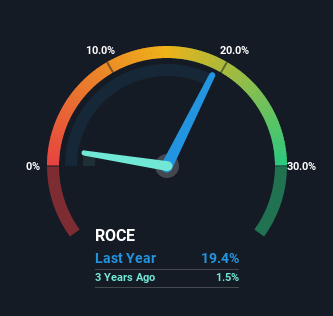To find a multi-bagger stock, what are the underlying trends we should look for in a business? Ideally, a business will show two trends; firstly a growing return on capital employed (ROCE) and secondly, an increasing amount of capital employed. This shows us that it's a compounding machine, able to continually reinvest its earnings back into the business and generate higher returns. So when we looked at ALPHA ADRIATIC d.d (ZGSE:ULPL) and its trend of ROCE, we really liked what we saw.
What Is Return On Capital Employed (ROCE)?
For those who don't know, ROCE is a measure of a company's yearly pre-tax profit (its return), relative to the capital employed in the business. The formula for this calculation on ALPHA ADRIATIC d.d is:
Return on Capital Employed = Earnings Before Interest and Tax (EBIT) ÷ (Total Assets - Current Liabilities)
0.19 = Kn71m ÷ (Kn546m - Kn179m) (Based on the trailing twelve months to September 2022).
So, ALPHA ADRIATIC d.d has an ROCE of 19%. In absolute terms, that's a satisfactory return, but compared to the Infrastructure industry average of 8.4% it's much better.
Check out our latest analysis for ALPHA ADRIATIC d.d

Historical performance is a great place to start when researching a stock so above you can see the gauge for ALPHA ADRIATIC d.d's ROCE against it's prior returns. If you're interested in investigating ALPHA ADRIATIC d.d's past further, check out this free graph of past earnings, revenue and cash flow.
What Can We Tell From ALPHA ADRIATIC d.d's ROCE Trend?
We're pretty happy with how the ROCE has been trending at ALPHA ADRIATIC d.d. We found that the returns on capital employed over the last five years have risen by 410%. That's not bad because this tells for every dollar invested (capital employed), the company is increasing the amount earned from that dollar. Interestingly, the business may be becoming more efficient because it's applying 63% less capital than it was five years ago. If this trend continues, the business might be getting more efficient but it's shrinking in terms of total assets.
For the record though, there was a noticeable increase in the company's current liabilities over the period, so we would attribute some of the ROCE growth to that. Effectively this means that suppliers or short-term creditors are now funding 33% of the business, which is more than it was five years ago. Keep an eye out for future increases because when the ratio of current liabilities to total assets gets particularly high, this can introduce some new risks for the business.
The Key Takeaway
In a nutshell, we're pleased to see that ALPHA ADRIATIC d.d has been able to generate higher returns from less capital. Investors may not be impressed by the favorable underlying trends yet because over the last five years the stock has only returned 12% to shareholders. So exploring more about this stock could uncover a good opportunity, if the valuation and other metrics stack up.
Since virtually every company faces some risks, it's worth knowing what they are, and we've spotted 7 warning signs for ALPHA ADRIATIC d.d (of which 3 are significant!) that you should know about.
While ALPHA ADRIATIC d.d may not currently earn the highest returns, we've compiled a list of companies that currently earn more than 25% return on equity. Check out this free list here.
The New Payments ETF Is Live on NASDAQ:
Money is moving to real-time rails, and a newly listed ETF now gives investors direct exposure. Fast settlement. Institutional custody. Simple access.
Explore how this launch could reshape portfolios
Sponsored ContentNew: Manage All Your Stock Portfolios in One Place
We've created the ultimate portfolio companion for stock investors, and it's free.
• Connect an unlimited number of Portfolios and see your total in one currency
• Be alerted to new Warning Signs or Risks via email or mobile
• Track the Fair Value of your stocks
Have feedback on this article? Concerned about the content? Get in touch with us directly. Alternatively, email editorial-team (at) simplywallst.com.
This article by Simply Wall St is general in nature. We provide commentary based on historical data and analyst forecasts only using an unbiased methodology and our articles are not intended to be financial advice. It does not constitute a recommendation to buy or sell any stock, and does not take account of your objectives, or your financial situation. We aim to bring you long-term focused analysis driven by fundamental data. Note that our analysis may not factor in the latest price-sensitive company announcements or qualitative material. Simply Wall St has no position in any stocks mentioned.
About ZGSE:ULPL
Good value with slight risk.
Market Insights
Weekly Picks

Early mover in a fast growing industry. Likely to experience share price volatility as they scale


A case for CA$31.80 (undiluted), aka 8,616% upside from CA$0.37 (an 86 bagger!).


Moderation and Stabilisation: HOLD: Fair Price based on a 4-year Cycle is $12.08
Recently Updated Narratives

Airbnb Stock: Platform Growth in a World of Saturation and Scrutiny

Adobe Stock: AI-Fueled ARR Growth Pushes Guidance Higher, But Cost Pressures Loom

Thomson Reuters Stock: When Legal Intelligence Becomes Mission-Critical Infrastructure
Popular Narratives


Crazy Undervalued 42 Baggers Silver Play (Active & Running Mine)


NVDA: Expanding AI Demand Will Drive Major Data Center Investments Through 2026


The AI Infrastructure Giant Grows Into Its Valuation
Trending Discussion



